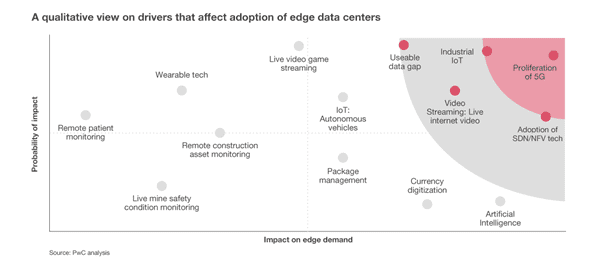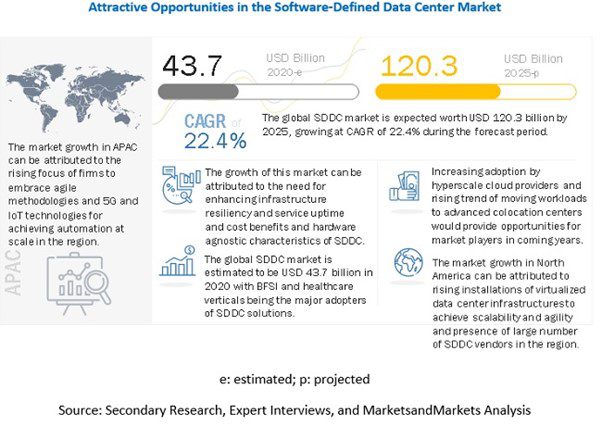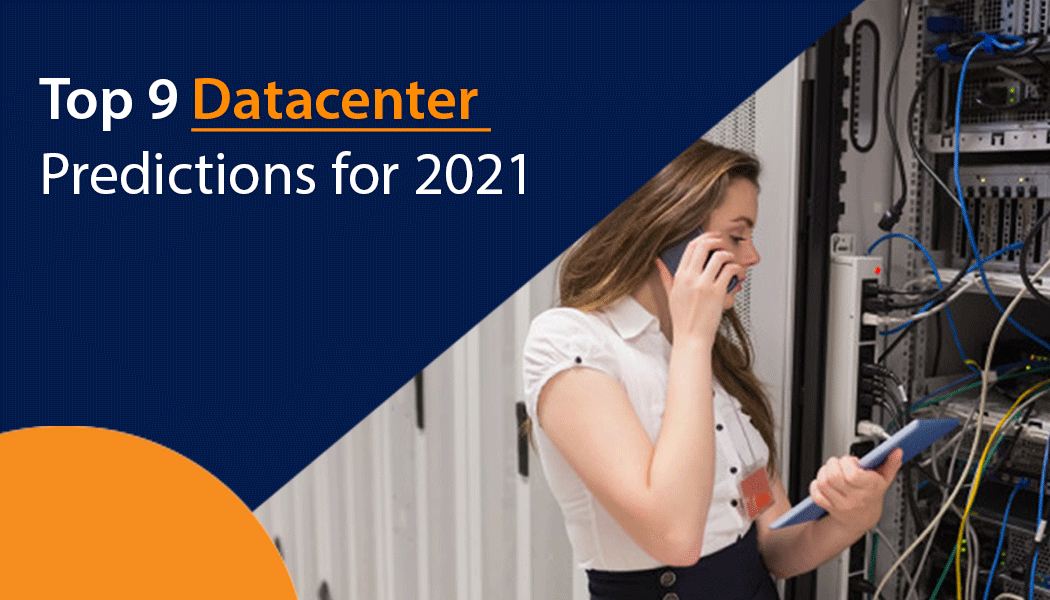Digital technologies are shaping the world economy in ways unimaginable and unheard of before. Data centers stand at the heart of these digital technologies – supporting their growth and development.
The importance of datacenters cannot be stressed enough. Especially, during the COVID-19 pandemic period, data center solutions have proved to be highly integral for ensuring business continuity and connectivity in organizations across countries. Datacenters supported the world’s economy – stopping it from collapsing by allowing people and organizations to shift to the new normal.
Today, as the pandemic drives the adoption of digital technologies, it would be interesting to see how these digital technologies trigger the growth of new data center trends.
The following article talks about the top datacenter predictions in 2021 and beyond.
Top 9 datacenter predictions in 2021
1. Increased demand for Edge Data centers
As remote work and smart technologies become a part of everyday lives, the demand for edge computing is set to rise.
Smart devices like intelligent sensors, autonomous vehicles etc. generate a large amount of data that needs to be processed in real-time. Let’s take the example of autonomous vehicles to get clarity.
Autonomous vehicles like self-driving cars produce data at a blazing fast speed. Sending this data to the cloud for processing is difficult due to high latency issues. Here, on-board computer processing will help make faster decisions like changing lanes or avoiding a collision. This will be possible through edge computing.
This will also give rise to micro data centers at the edge of the networks.
PwC, in one of their analysis, identified the following as drivers for the adoption of edge data centers.

Image Source: PwC
2. More demand for hyperscale infrastructure
The pandemic accelerated the digitization of almost every industry. Result? The demand for colocation and hyperscale infrastructure rose significantly. An increasingly large number of industries encouraged the adoption of digital strategies to support the remote workforce and also to keep their operations running.
Healthcare can be the perfect example here.
While there were talks of digital transformation in healthcare before the pandemic hit, the actual scenario further validated that need.
Healthcare industries across the world are looking for agile cloud operations to manage and run lab operations and even to manage patient data.
Supply chain and logistics industries, which were also badly affected during the pandemic, are now considering the shift to the cloud to ensure seamless operations during these tough times.
All this will lead to the demand for more computing and hence data centers. Hyperscalers like AWS, Google, and Microsoft are already leading the pack by making huge investments in datacenters and acquiring colocation spaces as well.
3. Sustainable data centers will be in trend
As the data center industry becomes more prominent, there is an increase in the talks about green data center practices or sustainable data centers – this includes adopting practices that will considerably reduce the carbon footprint of the environment.
Multi-tenant data centers are termed as one of the largest consumers of electric power.
According to reports, data centres in the US alone consumed approximately 73,000 megawatts (MW) in 2020. The US Department of Energy further estimated that large multi-tenant data centres may require more than 100 megawatts of power capacity, which is enough to power 80,000 US households, or a small city.
Because of this, data center infrastructure providers worldwide need to play a central role in lessening their environmental impact.
This may include steps like using lithium-ion batteries to reduce climate change at an international level.
Enterprise customers, who are more conscious of the environmental impact of data centers, are more driven towards following a sustainable data center practice.
This trend is also being adopted by data center investors who now look towards more sustainable data center portfolios. Big tech companies like Equinix have already started investing in green initiatives, and others are expected to follow suit.
4. 5G will drive datacenter growth
The past few years have seen a lot of discussions around 5G. While parallel development of smart technologies and more connected IoT devices is driving the demand for edge computing, achieving it would seem a bit difficult without 5G.
The wait for the 5G rollout, is having a domino effect on the data center growth. To truly benefit from 5G, data centers, as well as the service providers, need to rethink their infrastructure offerings and their structure.
There would be more focus on AI (artificial intelligence) and machine learning-based technologies to process the vast amount of data produced by 5G. Not only this, but the processing will need to happen at the edge. Thus, we may see a shift from cloud-scale data centers towards more localised and low-latency services.
5G is positioned to bring faster computing capability for individual as well as enterprise users.
5. Cloud and digital transformation will accelerate datacenter industry
The pandemic has accelerated the digital transformation of both small and large scale organizations to a vast extent. Most of the digital transformation happens in the cloud.
Cloud has become the yardstick for companies’ digital strategies and goals.
As such, networking in data centers must now support more cloud-based applications and software.
The need for anytime-anywhere connectivity has also increased due to the rising number of employees being permanently shifted to the remote work model.
Today, more than data centers, we are talking about centers of data. It is going to be one of the most integral datacenter predictions in 2021.
These applications and users decide where and when data is generated and processed. This is the reason why edge data centers seem so viable at the present moment.
6. Automation will grow
One of the most important datacenter predictions to note this year is the growth of automation. Automation is the need of the hour. As companies shift to remote working models and even companies’ supply chain shrinks, people will rely on more automated processes with less to no human intervention required.
Many data center infrastructure providers will depend on automation to maintain and record routine data center services like updating and patching.
This dependence on automation will continue to grow both in the hyperscalers and edge data center space.
7. Datacenter-as-a-Service will trend
Today the customers are looking at new ways of consuming services. This holds true for the data center solutions as well.
They want to buy and maintain data center solutions in a consumption-based and pay-per-use model.
While public cloud providers are already offering services in this model, now the data center providers too, need to come up with more flexible ways of providing their services.
The winners would be the early adopters – the ones who are able to sell their data center infrastructure in a new way.
8. Monitoring and visibility services will be in demand
There was a time when data centers were located on-premises, allowing organizations to keep a close watch on their resources and have greater visibility.
But as data centers move to the external locations and collocated spaces take center stage, monitoring and visibility tend to slip away. This is the reason why these data centers providers have come up with intelligent monitoring solutions to allow IT managers to have full control and visibility into their data center infrastructure even if they are located miles away from them.
These business intelligence software provide smart monitoring, tracking, and usage pattern access to their owners. The need for intelligent monitoring solutions for data centers will only increase in the future.
9. Rise of software-defined data centers (SDDC)
A software-defined data center model refers to a data storage facility in which all infrastructure elements – including the storage, networking, CPU, and security – are virtualized and delivered as-a-service.
Here, the CPU and the memory are decoupled from their underlying physical hardware. This creates a pool of resources for use whenever required.
Each virtualized application is then encapsulated in a separate and isolated software container – what we know as a virtual machine.
According to a report by Marketsandmarkets, The global Software-Defined Data Center (SDDC) market size is projected to grow from USD 43.7 billion in 2020 to USD 120.3 billion by 2025, at a Compound Annual Growth Rate (CAGR) of 22.4% during the forecast period.

Image source: Marketsandmarkets
The SDDC offer a more agile, scalable, and secure network by allowing you to run and process applications in real-time. It further simplifies data center management – as everything from routers and switches to servers and storage is virtualized. This virtualization helps in increasing the speed of delivery by automating a lot of processes.
Currently, the market for SDDC is dominated by big players like VMware, Oracle, and Microsoft. We may see more players emerging in the coming years. It is also one of the most interesting datacenter predictions for 2021.
Datacenter of the future
Looking at the rapid advancement in digital technologies, it is needless to say that the data center industry is set to record major growth.
But this time, this growth will be coupled with an increased demand for:
- Speed and uptime
- Energy and efficiency
- Safety and remote operations
Automated tracking and monitoring, followed by virtualization, point towards a futuristic data center – where humans have little to no involvement after the initial installation and setup. Considering the present pandemic situation, it does seem like the perfect solution towards better business continuity.
Technologies like AI and machine learning will further help in automating the data center technologies in the future.
We hope you enjoyed reading the datacenter predictions. Do share your thoughts in the comments section below.
Read Next: Top 10 best data center service providers in India 2021








